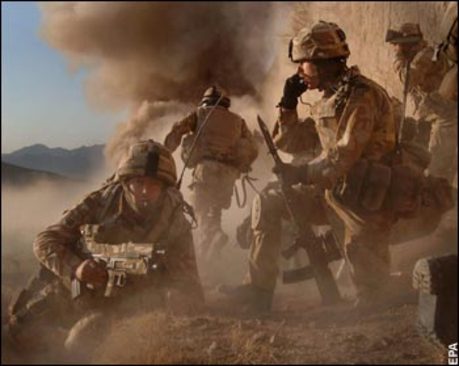The Afghanistan War
When you hear ‘9/11’, what do you think of? Where were you when it happened? That date has definitely left an indelible mark on all of us. Since the attack of September 11, 2001, we have been fighting a war to dismantle a terrorist group called Al-Quada (the people who organized the 9/11 attacks). Here’s an overview of what happened there: the U.S. invaded Afghanistan (yes, they invaded Afghanistan before Iraq, to all the people who thought otherwise) to overthrow the Taliban and destroy the Al-Quada terrorist network it supported in response to attacks on the World Trade Center in 2001 and other terrorist attacks in London, Bali, North Africa, Isalamabad and Kabul. These all built up and after the U.S. was attacked, they finally took action. Since then, the International Security Assistance Force (ISAF), under NATO (North Atlantic Treaty Organization) leadership has worked to stabilize economic, political, and security conditions, for the growth of an effective, democratic national government in Afghanistan. Along with that, the U.S. and it’s allies continue to pursue Al-Quada.
“So I want the American people to understand that we have a clear and focused goal: to dismantle, disrupt, and defeat Al-Qaeda in Pakistan and Afghanistan, and to prevent their return to either country in the future,” said President Obama, about the overall goal of the war. He then said that, as part of the first part of his new strategy, the United States, Pakistan, and Afghanistan will meet regularly in a trilateral “dialog”, with Secretary of State Hillary Clinton and Secretary Gates leading their effort. “Together,” he said, “we must enhance intelligence sharing and military cooperation along the border, while addressing issues of common concern like trade, energy, and military development …To succeed, we and our friends and allies must reverse the Taliban’s gains, and promote a more capable and accountable Afghan government.”
The second part of Obama’s strategy is to train and increase the Afghan security force. That is when, Obama said, the Afghan people can take responsibility for securing their own country and the troops can come home. The U.S. is also looking to deploy 4,000 troops (of those 30,000) to train Afghan police forces, their army, and security forces later this spring.
“Every American unit in Afghanistan will be partnered with an Afghan unit, and we will seek additional trainers from our NATO allies to ensure that every one of their units has a coalition partner,” said Obama, detailing the second part of his plan for Afghanistan.
The third part of his plan he says is to increase the number of soldiers on ground to help the Afghan government serve its people. Those soldiers will probably be agricultural specialists and educators; engineers, and lawyers, to train the Afghan people.
“That is why we must seek civilian support from our partners and allies, from the United Nations, and international organizations–an effort Secretary Clinton will carry forward next week in the Hague.” President Obama said.
Finally, the last two parts of Obama’s strategic plan for Afghanistan are to increase budget for Inspector Generals in the State Department, USAID, and a Special Inspector General for Afghan reconstruction; he will set a new compact with the Afghan government that cracks down on corrupt behavior, and sets clear benchmarks for international assistance so that it is used to provide for the needs of the Afghan people. He also said that he wants the U.S. to work with local leaders, the Afghan government, and international partners to have a “reconciliation” process in every province, because of some Afghanistan people being coerced to take up arms.
So clearly, the President has a set plan; but can he stick to it and not doubt it? According to an OP- ED New York Times columnist Frank Rich he is not sending the amount of soldiers General Stanley McChrystal requested (up to 80,000 troops). Instead, he’s sending 30,000 American soldiers. So far, in my book, he is not sticking to it already. It’s hard to understand what he was thinking, I guess he either didn’t want to endanger that many lives, or he did not think he needed that many soldiers. President Obama also said that this is a just (meaningful) war, so if he thinks so, why is he not sending the maximum amount of soldiers the General asked for?
“Obama is in a tough spot; If he pulls the troops out, the Taliban will take over and they could launch another attack on the U.S. If they don’t send those troops in, we may lose the war,” said Mr. Pollock on the war. “I do not approve of his decision. I don’t think this war is winnable. #1 the Afghan government is not capable of governing and is corrupt, and #2 it’s really not worth the American lives being lost.”
I have decided against his decision of sending those troops in. Here’s why. The Afghanistan government, as Mr.Pollock and President Obama said, is corrupt. Obama said that they will complete a compact with the Afghan government to crack down on corrupt behavior. My challenge is, if it’s corrupt, how can you reason with that government? Also, to answer one of President Obama’s earlier remarks about Al-Quada attacking us, didn’t we improve our security after 9/11 drastically? Yes, there were those two idiots breaking into the White House, and that mini-war down in Fort Hood, Texas, courtesy of the so called “psychologist”. But we could easily improve our security again. And yes, Al-Quada could strike in other countries, but I’m leaving that one up to him.











